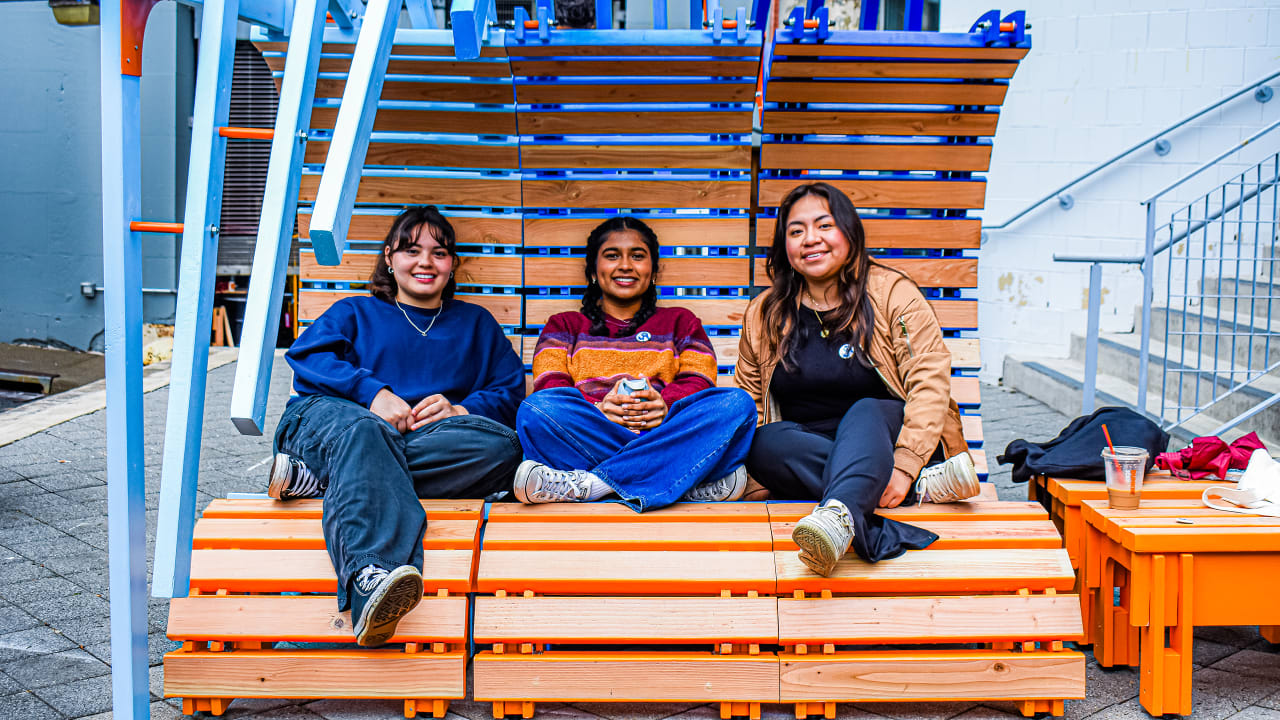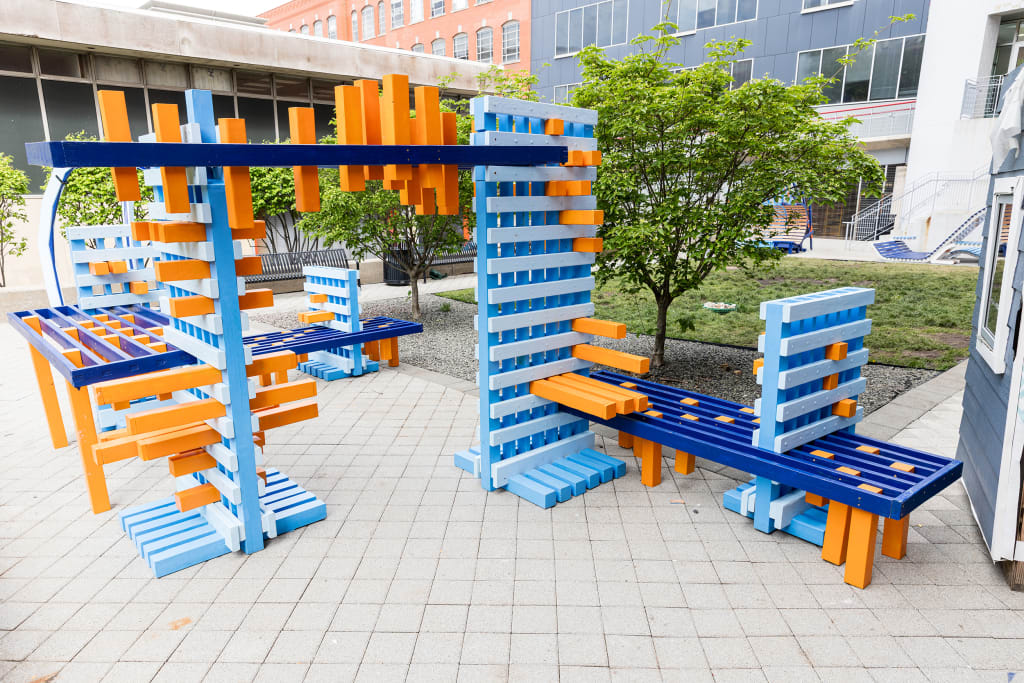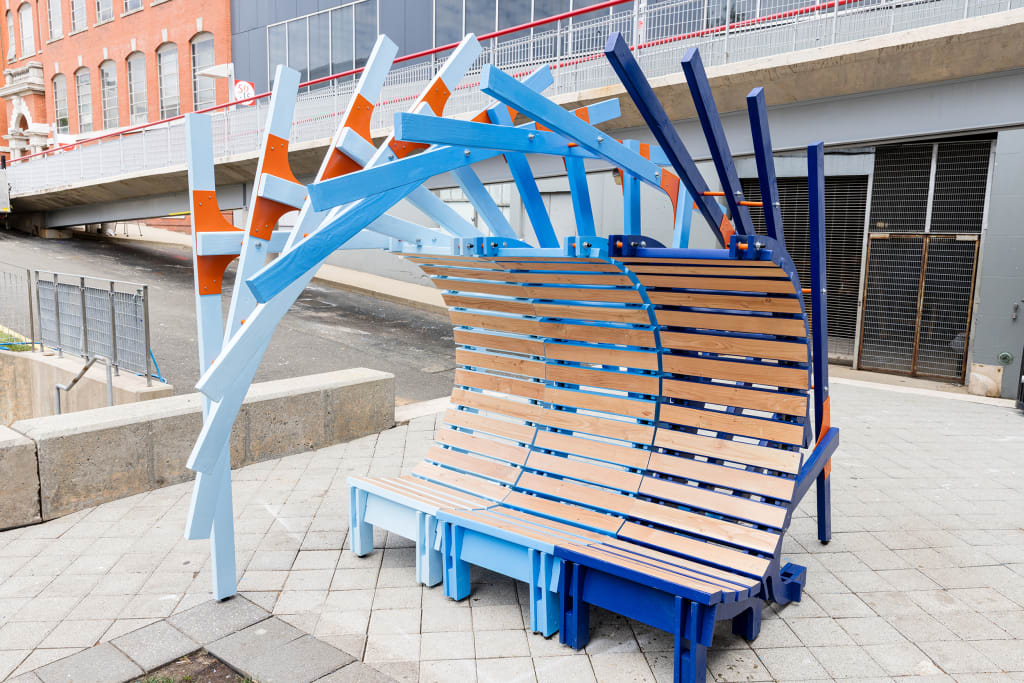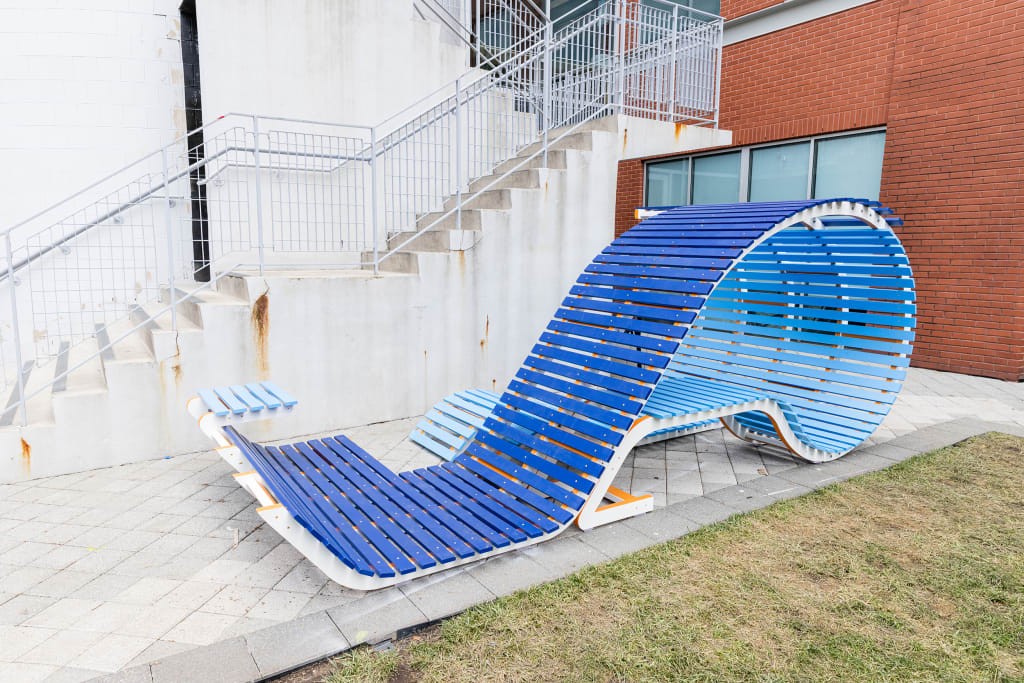Students designed these unusual cabanas to bring shade to Newark’s public pools
Five public pools in Newark, New Jersey, just got an unusual upgrade. Painted in bright neon colors and sporting far-out shapes, five custom-designed cabanas have been installed on the decks of these public pools, one at each location. Created by second-year design-build students at the New Jersey Institute of Technology’s Hillier College of Architecture and Design, the cabanas offer seating, shading, and a generally unconventional poolside experience. The cabanas are the result of a 15-week college-wide design project involving roughly 170 students. Initiated through a long-standing relationship between Newark’s recreation department and NJIT senior lecturer Mark Bess, the project was aimed at filling a large void in the city’s public pool offerings. “The pool areas didn’t have any types of amenity at all. It was essentially concrete platforms. There was nothing there,” Bess says. “This provided some useful function as well as giving the students an opportunity to stretch out a little bit.” [Photo: Hillier College of Architecture and Design] A public private partnership was formed between NJIT, the city of Newark, and the logistics real estate company Prologis, which provided $16,500 in funding for the cabanas. “Cities don’t often have the budget for state-of-the-art amenities like this, so this public-private partnership is a model for how municipalities can find creative solutions to improve public resources,” says Donnell Redding, director of Newark’s Department of Recreation, Cultural Affairs and Senior Services. [Photo: Hillier College of Architecture and Design] Erin Pellegrino, an adjunct instructor at NJIT, worked with students on the designs, and held regular reviews with city officials and Prologis to review the ideas taking shape. Participating students initially came up with dozens of concepts that then got whittled down to 10 finalist ideas. Through 3D design and scale physical modeling, the students landed on five final designs that they then built themselves. The cabana designs range from familiar lounge chairs to more experimental shade structures. “We actually try to avoid using the word cabana at the early stages,” says Pellegrino. “We try to tell students this is a pavilion. It needs to host sitting and laying and, you know, relaxing . . . perhaps even eating and communicating. So we try to give them verbs instead of nouns.” [Photo: Hillier College of Architecture and Design] One of the cabanas is a row of chairs with rounded backs and an overhang that folds from behind like a crashing wave. Another is a geometrical puzzle of benches, tables, and walls that looks like it’s made out of Tetris blocks. Another resembles the metal fingers of an arcade’s claw machine, draped with fabric shade cloth. “We give them a long leash, particularly early on,” Pellegrino says. “That usually results in some really interesting ideas. Then, when they have to build it, and they have to sit in it, that’s when they start to refine it and bring it back to reality.” [Photo: Hillier College of Architecture and Design] Pellegrino and other NJIT instructors helped ensure the designs were feasible from a variety of perspectives, including the $16,500 budget provided by Prologis, the liability the school faced by putting these objects in public places, and even logistical issues like how much each cabana weighs and how it would be transported from the college to the pool. The cabanas were installed in late May. Pellegrino says an in-kind donation from a local paint store of about $3,000 worth of paint and other finishing materials should set the cabanas up to survive for at least five years, if more aren’t requested sooner. “I would love to do it again. There’s certainly room for more of these things at most public pools and other kinds of public spaces,” Pellegrino says. “But that’s going to be dependent on money, like everything else.”

Five public pools in Newark, New Jersey, just got an unusual upgrade. Painted in bright neon colors and sporting far-out shapes, five custom-designed cabanas have been installed on the decks of these public pools, one at each location. Created by second-year design-build students at the New Jersey Institute of Technology’s Hillier College of Architecture and Design, the cabanas offer seating, shading, and a generally unconventional poolside experience.
The cabanas are the result of a 15-week college-wide design project involving roughly 170 students. Initiated through a long-standing relationship between Newark’s recreation department and NJIT senior lecturer Mark Bess, the project was aimed at filling a large void in the city’s public pool offerings. “The pool areas didn’t have any types of amenity at all. It was essentially concrete platforms. There was nothing there,” Bess says. “This provided some useful function as well as giving the students an opportunity to stretch out a little bit.”

A public private partnership was formed between NJIT, the city of Newark, and the logistics real estate company Prologis, which provided $16,500 in funding for the cabanas.
“Cities don’t often have the budget for state-of-the-art amenities like this, so this public-private partnership is a model for how municipalities can find creative solutions to improve public resources,” says Donnell Redding, director of Newark’s Department of Recreation, Cultural Affairs and Senior Services.

Erin Pellegrino, an adjunct instructor at NJIT, worked with students on the designs, and held regular reviews with city officials and Prologis to review the ideas taking shape. Participating students initially came up with dozens of concepts that then got whittled down to 10 finalist ideas. Through 3D design and scale physical modeling, the students landed on five final designs that they then built themselves.
The cabana designs range from familiar lounge chairs to more experimental shade structures. “We actually try to avoid using the word cabana at the early stages,” says Pellegrino. “We try to tell students this is a pavilion. It needs to host sitting and laying and, you know, relaxing . . . perhaps even eating and communicating. So we try to give them verbs instead of nouns.”

One of the cabanas is a row of chairs with rounded backs and an overhang that folds from behind like a crashing wave. Another is a geometrical puzzle of benches, tables, and walls that looks like it’s made out of Tetris blocks. Another resembles the metal fingers of an arcade’s claw machine, draped with fabric shade cloth.
“We give them a long leash, particularly early on,” Pellegrino says. “That usually results in some really interesting ideas. Then, when they have to build it, and they have to sit in it, that’s when they start to refine it and bring it back to reality.”

Pellegrino and other NJIT instructors helped ensure the designs were feasible from a variety of perspectives, including the $16,500 budget provided by Prologis, the liability the school faced by putting these objects in public places, and even logistical issues like how much each cabana weighs and how it would be transported from the college to the pool.
The cabanas were installed in late May. Pellegrino says an in-kind donation from a local paint store of about $3,000 worth of paint and other finishing materials should set the cabanas up to survive for at least five years, if more aren’t requested sooner.
“I would love to do it again. There’s certainly room for more of these things at most public pools and other kinds of public spaces,” Pellegrino says. “But that’s going to be dependent on money, like everything else.”





















































































































































